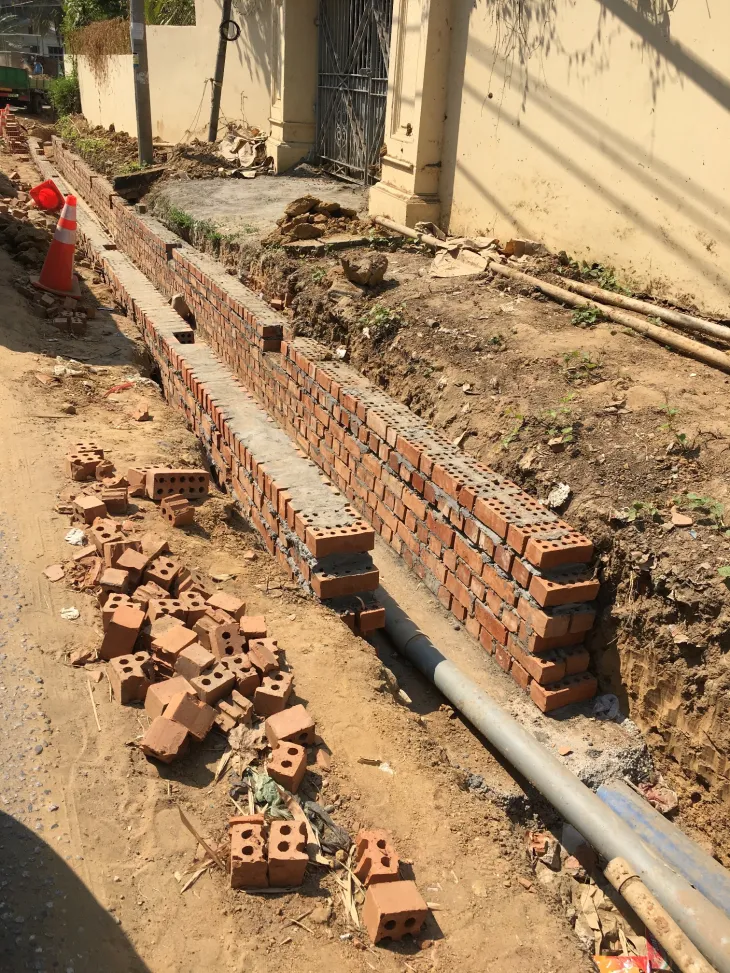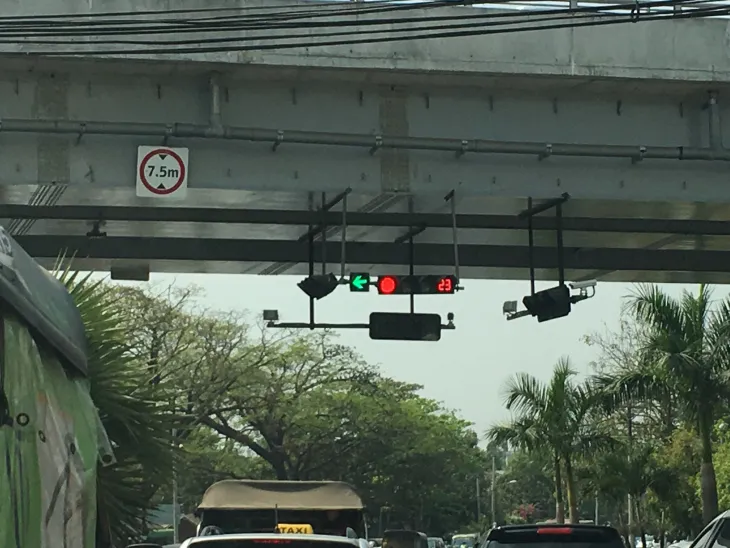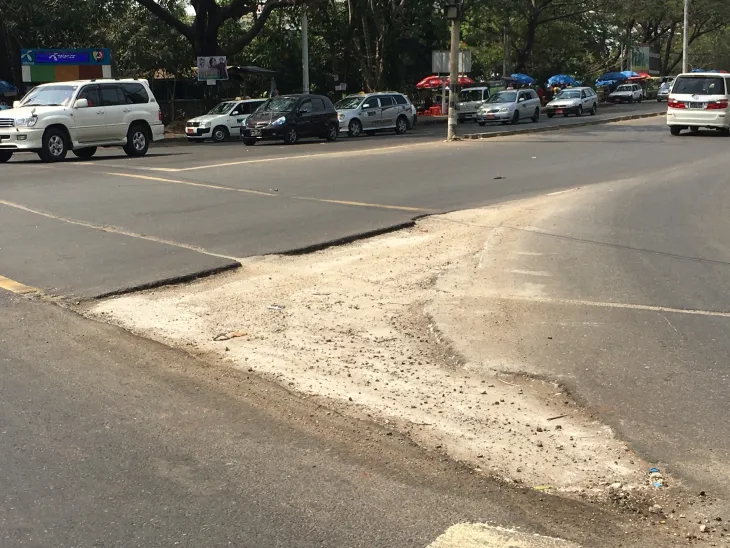Aung Khant muses on Yangon’s drainage and infrastructure challenges.
Journey across Yangon on any given day at this time of year, and it is a sure bet to stumble upon a renovation site by the side of the road. During the dry-season, city authorities and private citizens alike spend most of their time and effort on making repairs as workers clear out the debris and blockage out of the drains.

Recently, I stumbled upon such a site on Thanlwin road, in Yangon’s glitzy Golden Valley area. Aptly named and full of lush gardens and palatial houses, the valley is surrounded by a confusing branch of roads that lie in a state of drastic disparity to the homes of its residents. The roads are so full of potholes that have been there for so long, they seem to be some form of ironic contrast to the neighbourhood’s name: Golden Valley is colloquially teased as golden “rocks” valley (in English) for its bumpy roads as a reference to the famous golden rock pagoda Kyaiktiyo, or in Burmese as “water valley” (yay-taung-gyar) for its frequent floods and overflowing drains.

Yangon, like most Southeast Asian cities, is no stranger to the torrential monsoon downpours and dry summer spells. Yet, for a city that has historically faced the same weather challenges again and again each year, both private developers and city planners of Yangon have been terrible at managing this key element. Sunshine and rain alike are treated as nature’s challenges, and often neglected are the actual potential advantages that they bring to the city: essentially free water, heat and solar energy. Despite the presence of several solar companies, they are not yet very visible, and efforts to use heat-capture technology are mere school science-fair mockups at the moment. The city’s management of the monsoon waters, which should have been solved long ago since the rain is not a surprise, is unbelievably still a continued battle against nature. The engineers of the infamous YCDC (Yangon City Development Committee) municipal departments have spent decades trying to build a proper drainage system, only to have their efforts be in vain due to the lack of proper technical expertise and management. On Thanlwin road, workers toiled hard on construction, and yet it was a sad sight to see that the engineers responsible for overseeing this had not consulted a proper design for V-shaped drains. Rather, they stuck to the old tested and failed rectangular shapes, that would collect sediment as fast as they could be built and are a sure shot to get clogged by the next monsoon.

For years, the YCDC has been caught in a stagnant quagmire on this issue of creating and managing a well-functioning public infrastructure. In their defence, having only manpower and simple bricks and mortar meant that they lacked the proper equipment, yet it does bring to question if they have indeed learned anything at all after this time of trial and error.
Most of the city’s drainage systems and underground water pipelines date back to 1888 during the colonial era, and many have fallen apart after years of neglect and rising usage. Originally designed by British engineers to cater to just six townships of around 40,000 inhabitants, the sewers now serve about 350,000 or 9 times more than their original capacity. Because of repeated mistakes, the YCDC is continuously having to deal with repairs to patch up the tattered system, rather than implement actual improvements. In the face of the city’s growth and rising number of residents, it is simply not viable to keep relying on these old sewers and pipes. There have already been casualties from old, faulty and neglected public infrastructure such as electrocution in downtown streets.
To add further headache to this issue, much of the city’s natural landscape was artificially altered by the previous military government, which failed to properly consult the geographical topography in Yangon before issuing drastic changes. Many of the natural ponds, streams, reservoirs and waterways that were key in directing and evacuating excess water during the monsoons were victims of imposed landfills by the junta administration; this is one of the primary reasons why Golden Valley and other areas throughout the city keep flooding with every rain. Most of these alterations most likely involved heaps of corruption that we may never hear about, and yet the blame goes to natural phenomena, as is the usual scapegoating.

Many of the traffic intersections in Burma have also been undergoing some confusing changes, with some having multiple traffic lights that are not only confusing for road users, but also highly unsafe. The city has also had multiple traffic islands being built and taken off repeatedly, a process that is costly and damaging to the city’s shifting facades. A clear, comprehensive, well thought-out urban plan that can hold valid through the test of time, is said to be in the works but has yet to be released by the public administration.

Private developers too, have been overly keen on bringing the latest touch of contemporary, cosmopolitan designs, and the most recent fashion has been to imitate high-rises in cities of the likes of Manhattan, complete with immense floor-to-ceiling glass windows. Not only are the design ideas for these buildings imported, the same goes quite often for the costly building materials as well. By totally neglecting the natural conditions of strong sun and heavy rain, the developers are faced with a constant battle against the tides of nature and are forced to install costly and environmentally unfriendly air-conditioning units. Health-wise for the residents, heatstrokes and colds are often induced from the extreme temperature differences between indoors and outdoors. Most ironic of all is to see thick curtains being installed to block out the sun. After all that effort, the residents who have paid an arm and a leg cannot even properly enjoy the view.
By marketing these imported concepts and emulating development in the westernised sense, private developers end up offering unrealistic and costly housing options. The design language itself has not been an organic evolution from our traditions and techniques, and thereby fails to adhere to the local conditions. These costly consumptions lead to a larger impact throughout the country as well, where smaller towns and communities are left without functioning access to electricity because of the city’s big appetite for it, roughly half of the country’s available output.
By comparison, many of the old and historic buildings that are scattered around town have managed to navigate around these problems through very old-school techniques. Old monasteries, for example, are often just two or three stories high, with very high ceilings and louvers installed for natural ventilation. This keeps the space inside under cover and shade, creating a flowing current of natural air and minimising temperature fluctuations through the day. The use of wood as the primary material for the future helps mitigate the heat by absorbing temperature and regulating humidity levels.
The cases above are just a few of the many examples of bad architectural approaches and poor city planning that have plagued Yangon in recent years. Any architect, engineer, urban planner or city authority that has some common sense will see that the city needs some serious urban realignment before properly moving forward. Efforts to truly modernise the city have been impeded by the constant failure of existing infrastructure against the test of time and nature. With each monsoon season, Yangon goes through a period of destruction and repair. With each step in building anew, we take two steps back in degradation after the monsoons.
This article only captures a small fragment of the larger problem of the lack of a comprehensive outlook for urban development. It is because of this root cause that not only are the roads of Golden Valley littered with potholes, so are the main roads and highways all over the city and beyond. These challenges are very basic issues, but nonetheless must be overcome, for any effort towards progress will otherwise just be the equivalent of running in quicksand, or perhaps more fittingly in Buddhist terms, a vicious cycle of repeated repairs and not a lot of real progress. With the escalation of global climate change, the situation can only become more dire.
A first step to tackling this issue is to embrace nature as a welcome advantage, not as a hindrance, in our progress towards development. The YCDC’s battles with nature can simply never be won, and city planning should fully take this into account and incorporate both elements of the dry-season and the monsoon, with a clear objective to utilise and harness the potential advantages to the full extent. Yangon should steer away from the mistakes of other South-East Asian cities that have sacrificed their greenery to become vast concrete jungles. Attempts like those led by FREDA (Forest Resource Environment Development and Conservation Association) that launched last year with plans to plant around 50,000 trees in the Yangon region should have further reach into the heart of the city center as well.
All efforts for Yangon’s development will rely on the rigidity of the public infrastructure and private projects of today, thus it is in the interest of everyone to rightfully correct this flimsy balance. If the foundations of the city are not secured, its future will not be either.
Alex Aung Khant is Executive Director at Urbanize, a local policy institute for urban and regional planning. Alex is from Yangon, Myanmar, and holds a Masters degree in Urban Studies and Public Policy from Sciences Po in Paris, France. He obtained his B.A. in Political Science and Asian Studies, also from Sciences Po Paris.
Like This Article
June 18, 2024
November 22, 2023
April 26, 2023
April 03, 2023

Center for Southeast Asian Studies, Asian Institute 1 Devonshire Place Toronto, Ontario, M5S 3K7, Canada
©TeaCircle All Rights Reserved 2023